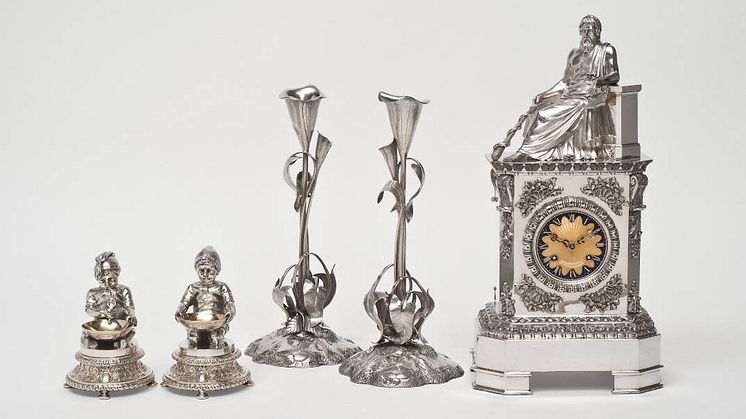
Press release -
New acquisition: Silver by Gustaf Möllenborg
Nationalmuseum’s collection of applied art and design now includes a number of pieces made in silversmith Gustaf Möllenborg’s workshop in Stockholm. The new acquisitions, which comprise a mantel clock, a pair of candlesticks and two salt cellars featuring elves eating porridge, are on display at the museum in the gallery of applied art and modern design.
Nationalmuseum’s collection of 19th-century silver has expanded with the addition of three new acquisitions, all made in Gustaf Möllenborg’s workshop inStockholm. The oldest of the objects is a late Empire mantel clock made in 1844, which was presented to King Oscar I’s personal physician, Professor Magnus Huss, by grateful patients. The pendulum clock is no doubt a special commission, since the decoration depicts the god of medicine, Asclepius, and one of the hands bears his serpent-entwined staff. The candlesticks, in a typically naturalistic style, were made in 1852 and were also a gift, this time to the chairman of the Uppsala Students’ Union to commemorate a student march fromUppsalatoChristiania. The salt cellars decorated with two elves eating porridge date from 1899 to 1900 and were an accompaniment to the ‘elf service’ that was a gift from the women of Sweden to the Crown Prince couple Gustaf and Victoria in 1881.
Gustaf Möllenborg (1796-1851) became an apprentice to a silversmith in Växjö at the age of 13, before moving toStockholmin 1819. He became a master silversmith in 1823, at the age of 26. Möllenborg’s workshop expanded rapidly and had over 40 employees by the 1840s, making itSweden’s biggest producer of decorative works in gold and silver. In 1850, the year before his death, Möllenborg passed his business on to one of his journeymen and the company continued until 1927, when the contents of the workshop were donated to Nordiska Museet.
This acquisition considerably strengthens Nationalmuseum’s collection of silver from the 19th century, a period not widely represented among existing works. It has been made possible due to a gift from the Barbro Osher Foundation. Since Nationalmuseum has no funds of its own for the purchase of art and design, its collection can only be expanded through donations and funding from private foundations.
The new acquisition is on display in the museum’s gallery of applied art and modern design.
Further information
Anders Bengtsson, curator applied art and modern design, anders.bengtsson@nationalmuseum.se, +46 8 5195 4385
Hanna Tottmar, press officer, hanna.tottmar@nationalmuseum.se, +46 8 5195 4390, +46 767 23 46 32
Press images
www.nationalmuseum.se/pressroom
Caption
Silver salt cellars (1899-1900), designed by Magnus Isaeus and John Börjeson for the Gustaf Möllenborg Company; Silver candlesticks (1852), the Gustaf Möllenborg-Féron Company; Mantel clock in silver, gold and enamel (1844), Gustaf Möllenborg. Photo: Bodil Karlsson/Nationalmuseum.
Categories

